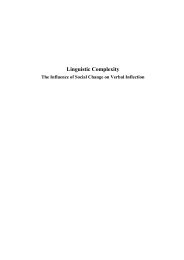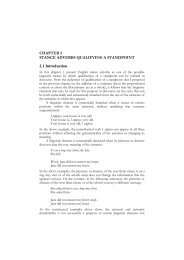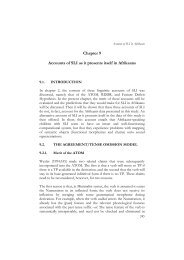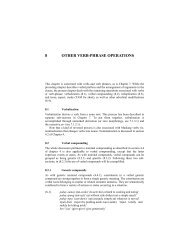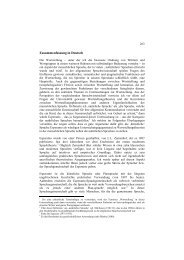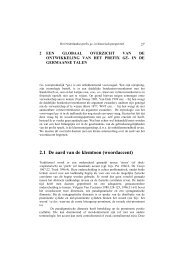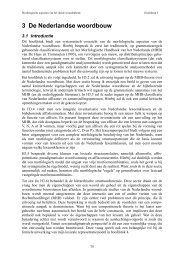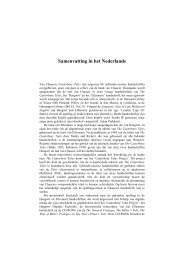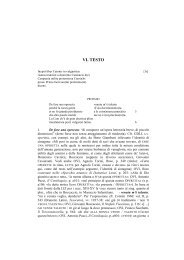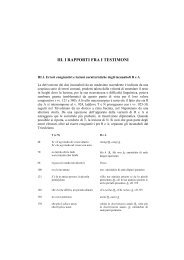Chapter 2 - LOT publications
Chapter 2 - LOT publications
Chapter 2 - LOT publications
Create successful ePaper yourself
Turn your PDF publications into a flip-book with our unique Google optimized e-Paper software.
<strong>Chapter</strong> 2<br />
12. k’orp’p’is-n k’orop’p’-is-e<br />
grasshopper-NOM jump- CAUS 1 -3M:PF<br />
‘A grasshopper jumped.’<br />
13. k’orp’p’is-n barr-is-e<br />
grasshopper-NOM fly- CAUS 1 -3M:PF<br />
‘A grasshopper flew.’<br />
(12) and (13) are intransitive causative of motion verbs. All structures have only one<br />
agentive subject. Despite the presence of the causative marking –is- no additional<br />
subject is introduced. There are also similar verbs such as daadd-is- ‘to start walking<br />
(for a child)’. This intransitive causative is derived from a nominal form daaddee<br />
‘walking of a child’. Verbs such as t’all-is- ‘to struggle to survive’ and k’at’t’is-<br />
‘to walk cautiously and slowly’ are intransitive causatives which are derived<br />
from ideophones. The fact that –is- could be dropped when the corresponding stems<br />
are used with the verb jeɗ ‘to say’ to express the same concept shows that –is- is not<br />
part of the verb root. For instance verbs such as k’orop’p’ jeɗ- ‘to jump/ lit., to say<br />
jump’, barr jeɗ- ‘to fly/lit., to say fly’, t’alt’al jeɗ- ‘to struggle for survival’, k’at’<br />
jeɗ- ‘to stop/lit., to say stop’ are ideophonic verbs. In these forms the causative –is-<br />
alternates with the verb to say jeɗ- ‘say’. Sound emission intransitive causatives<br />
include verbs such as korr-is- /korr jeɗ- ‘to moan’, č’all-is- / č’all jeɗ- ‘to be<br />
quiet’, girr-is / girr jeɗ- ‘to blaze’, etc. Ideophones can be used as verbs either by<br />
compounding them into the verb ‘to say’ or by verbalizing them through a causative<br />
suffix –is, CAUS 1 . Note that this de-ideophonic verbalizing causative is different in<br />
form from the de-adjectival verbalizer –(e)ess- CAUS 3 .<br />
2.4. The Semantics of Oromo Causatives<br />
I discuss the meanings of Oromo causatives on the basis of Kulikov (2001). According<br />
to Kulikov (2001: 891-893), causative meanings are characterized as direct vs.<br />
indirect, permissive, assistive, declarative and deliberate vs. accidental causation. He<br />
also notes that causative verbs may have reciprocal, intensive, iterative and distributive<br />
meanings although such meanings are less motivated since they are not associated<br />
with the core function of the causative (Kulikov 2001: 894); I do not discuss<br />
such cases since they are not observed in Oromo (Meč’a dialect).<br />
In Oromo only direct, indirect, assistive and similative 7 causations are relevant for<br />
the grammatical system of the language. Direct and indirect causations are known<br />
by different terms such as contact vs. distant; immediate vs. mediated (Kulikov<br />
2001: 892). Shibatani and Pardeshi (2001: 88) propose the terms ‘manipulative’ and<br />
‘directive’. Direct causatives are causatives in which the causer manipulates the<br />
7<br />
Similative causatives resemble what is called “declarative” in Kulikov (2001). I use the term<br />
‘similative’ because such causatives express meanings such as ‘look like’.<br />
20



